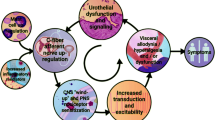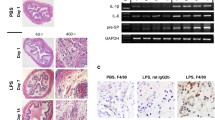Abstract
Substance P (SP) is a peptide found in the sensory nervous system which has multiple biologic effects including stimulation of muscle contraction, pain nociception, immune cell functions, plasma extravasation and a constellation of inflammatory effects. Here we investigate the role of SP in several animals models of bladder inflammation. Using the female Lewis rat, inflammation was induced using either xylene, lipopolysaccharide (LPS) or polyinosinic-polycytidylic acid (polyIC). Inflammation occurred rapidly (4 h) and was maintained in each model for at least 7 days. Each of these protocols decreased the bladder content of immunoreactive SP by approximately 50%, suggesting enhanced release. There was no change in the urinary frequency of these animals over 3 weeks, suggesting that urinary frequency changes are not mediated by acute inflammation. We also found that the SP receptor (NK1) antagonist, (−)CP96345, was unable to block the inflammation produced by polyIC, suggesting that SP is not an obligatory mediator of immune cell stimulation in this model.
Similar content being viewed by others
References
Bozic CR, Lu B, Hopken UE, Gerard G, Gerard NP (1996) Neurogenic amplification of immune complex inflammation. Science 273:1722
Eglezos A, Giuliani S, Giovanni V, Maggi CA (1991) Direct evidence that capsaicin-induced plasma protein extravasation is mediated through tachykinin NKI receptors. Eur J Pharmacol 209:277
Hartung HP, Wolters K, Toyka, KV (1986) Substance P: binding properties and studies on cellular responses in guinea pig macrophages. J Immunol 136:3856
Jansco N, Jansco-Gabor A, Szolcsanj J (1967) Direct evidence of neurogenic inflammation and its prevention by denervation and pretreatment with capsaicin. Br J Pharmacol 31:138
Leeman SE, Mroz EA (1974) Substance P. Life Sci 15:2033
Lembeck F, Donnerer J, Colpaert FC (1981) Increase of substance P in primary afferent nerves during chronic pain. Neuropeptides 1:175
Lotz M, Vaughan JH, Carson DA (1988) Effects of neuropeptides on production of inflammatory cytokines by human monocytes. Science 41:1218
Luber-Narod J, Kage R, Leeman SE (1994) Substance P enhances the LPS-mediated secretion of TNFα from neuroglial cells. J Immunol 152:819
Luber-Narod J, Austin-Ritchie T, Banner B, Hollins C III, Miramag C, Price H, Menon M (1996) Experimental autoimmune cystitis in the Lewis rat: a potential animal model for interstitial cystitis. Urol Res 24:367
Maggi CA, Abelli L, Giulianni S, Santicioli P, Geppetti P, Somma, V, Frili S, Meli A (1988) The contribution of sensory nerves to xylene-induced cystitis in the rat. Neuroscience 26:709
Payan DG, Brewster DR, Missirian-Bastian A, Goetzl EJ (1984) Substance P recognition by a subset of human T lymphocytes. J Clin Invest 74:1532
Ruff MR, Wahl SM, Pert CB (1985) Substance P receptormediated chemotaxis of human monocytes. Peptides 6 [Suppl. 2]:107
Saria A, Lundberg JM, Skofitsch G, Lembeck F (1983) Vascular protein leakage in various tissues induced by substance P, bradykinin, serotonin, histamine, and by antigen challenge. Naunyn-Schmiedebergs Arch Pharmacol 324:212
Snider RM, Constantine JW, Lowe JA, Longo KP, Lebel WS, Woody HA, Drozda MC, Desai FJ, Vinick FJ, Spencer RW, Hess H-J (1991) A potent non-peptide antagonist of the substance P (NKI) receptor. Science 251:435
Stein PC, Pham H, Parsons CL (1996) Bladder injury model induced in rats by exposure to protamine sulfate followed by bacterial endotoxin. J Urol 155:1133
Uchida K, Samma S, Rinsho K, Warren JR, Oyasu R (1989) Stimulation of epithelial hyperplasia in rat urinary bladder byEscherichia coli cystitis. J Urol 142:1122
Longmore J, Hill RG (1992) Characterisation of NK receptors in guinea-pig urinary bladder smooth muscle: use of selective antagonists. Eur J Pharmacol 222:167
Author information
Authors and Affiliations
Corresponding author
Rights and permissions
About this article
Cite this article
Luber-Narod, J., Austin-Ritchie, T., Hollins, C. et al. Role of substance P in several models of bladder inflammation. Urol. Res. 25, 395–399 (1997). https://doi.org/10.1007/BF01268854
Received:
Accepted:
Issue Date:
DOI: https://doi.org/10.1007/BF01268854




